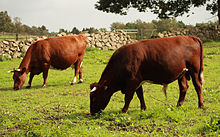 Cow and bull in the Skånes Djurpark, Höör, Skåne Cow and bull in the Skånes Djurpark, Höör, Skåne | |
| Conservation status | FAO (2007): endangered-maintained |
|---|---|
| Country of origin | Sweden |
| Use | milk |
| Traits | |
| Weight |
|
| Coat | black, red and white |
| Horn status | horned in both sexes |
| |
The Väneko is an endangered Swedish breed of dairy cattle. It is named for the village of Väne-Ryr in the landskap of Västergötland, in western Sweden. It is a traditional domestic Swedish breed, and derives from a group of cattle discovered in the 1990s, at a time when all traditional Swedish horned cattle were thought to have disappeared.
History
The Väneko is a traditional domestic Swedish breed. It is named for the village of Väne-Ryr [sv] in the Vänersborg Municipality of Västra Götaland, in the landskap of Västergötland in western Sweden.
It derives from a group of cattle discovered in the 1990s, at a time when all traditional Swedish horned cattle were thought to have disappeared. There is a programme of recovery and conservation of the breed. A herd-book for the breed was established in 1993.
The Väneko is grouped with two other endangered indigenous cattle breeds, the Ringamålako and the Bohuskulla, as Allmogekor, or roughly "Swedish native cattle". Conservation and registration of these populations is managed by a society, the Föreningen Allmogekon.
In 2014 the total Väneko population was reported to be 190.
Characteristics
The coat of the Väneko is multi-coloured, black or red, sometimes with white; the cattle may be solid-coloured, red or black pied, or colour-sided. Bulls weigh approximately 775 kg, cows about 525 kg.
Use
The Väneko is a dairy breed, kept principally for its milk; it is, however, not very productive. The only breeding aim is preservation of the breed without contamination from other breeds. It is maintained for social and cultural reasons, and may be used in vegetation management.
References
- Barbara Rischkowsky, D. Pilling (eds.) (2007). List of breeds documented in the Global Databank for Animal Genetic Resources, annex to The State of the World's Animal Genetic Resources for Food and Agriculture. Rome: Food and Agriculture Organization of the United Nations. ISBN 9789251057629. Accessed November 2016.
- ^ Breed description: Väne Cow. Department of Animal Breeding and Genetics, School of Veterinary Medicine Hannover. Archived 15 November 2007.
- ^ Swedish Cattle Breeds. North European Cattle Diversity Project. Archived 18 March 2009.
- (2002). Country report on animal genetic resources for food and agriculture in Sweden, annex to The State of the World's Animal Genetic Resources for Food and Agriculture. Rome: Food and Agriculture Organization of the United Nations. ISBN 9789251057629. Accessed November 2016.
- ^ Rawlynce C. Bett, Mwai A. Okeyo, Birgitta Malmfors, Kjell Johansson, Morris Agaba, Donald R. Kugonza, A.K.F.H. Bhuiyan, Anibal E. Vercesi Filho, Arthur S. Mariante, Fidalis D. Mujibi, Jan Philipsson (2013). Cattle Breeds: Extinction or Quasi-Extant?. Resources 2 (3): 335–357. doi:10.3390/resources2030335.
- ^ Breed data sheet: Väneko/Sweden. Domestic Animal Diversity Information System of the Food and Agriculture Organization of the United Nations. Accessed November 2016.
- Valerie Porter, Lawrence Alderson, Stephen J.G. Hall, D. Phillip Sponenberg (2016). Mason's World Encyclopedia of Livestock Breeds and Breeding (sixth edition). Wallingford: CABI. ISBN 9781780647944.
- Väneko (in Swedish). Föreningen Allmogekon. Archived 9 September 2016.
| Cattle breeds of Sweden | |
|---|---|
| These are the cattle breeds considered in Sweden to be wholly or partly of Swedish origin. Inclusion here does not necessarily imply that a breed is predominantly or exclusively Swedish. | |
|